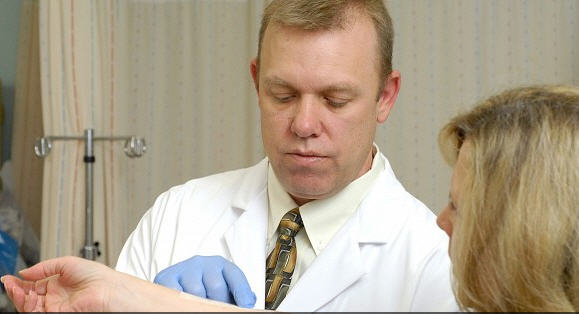A Better Way to Treat ACE Inhibitor Angioedema in the ED

Joseph Moellman, MD, in the emergency department at University Hospital performing a skin test for penicillin allergy
In angioedema, patients experience a rapid swelling of the skin and subcutaneous tissues—which, in some cases, can lead to airway obstruction and suffocation. Physicians usually treat angioedema like an allergic reaction with corticosteroids and antihistamines.
But that therapy doesn’t always work for another version of the condition, thought to be caused by taking a class of drugs known as ACE inhibitors.
“ACE inhibitors are a common treatment in patients with congestive heart failure and hypertension,” says Joseph Moellman, MD, associate professor of emergency medicine. “It is also the most common etiology of patients presenting to the emergency department with angioedema.”
Moellman says there’s currently no treatment for ACE inhibitor induced (ACEI) angioedema, as the physiology of the condition is different—caused by the levels of the blood vessel-dilating peptide bradykinin in the body.
In a triple blind, placebo-controlled phase-2 trial, Moellman worked with professor of medicine and angioedema expert Jonathan Bernstein, MD, and fellow researchers at the UC Medical Center Emergency Department to study the drug Ecallantide in the treatment of ACEI angioedema that failed to respond to the conventional therapy of corticosteroids and antihistamines.
They wanted to see if Ecallantide, which has already safely treated acute attacks of hereditary angioedema, could help patients with ACEI angioedema—specifically, if it could make them eligible for discharge within four hours of treatment.
After enrolling 50 patients in the study, they found that patients treated with Ecallantide were more likely to meet discharge sooner than those receiving antihistamines and steroids—31 percent of Ecallantide patients were eligible for discharge within four hours, as compared with 21 percent of patients receiving placebos. Additionally, patients experienced few side effects from the medication.
Moellman says the data supports launching a phase-3 trial, which will enroll more patients to confirm the initial results. He is presenting the results at the annual meeting of the Society for Academic Emergency Medicine, held May 14-17 in Dallas.
Co-authors of the study include Christopher Lindsell, PhD, Kimberly Hart and Sean Collins, MD. The study was funded by Dyax, manufacturer of Ecallantide, or Kalibtor. Bernstein is a consultant and speaker for Dyax.
Media Contact
All latest news from the category: Health and Medicine
This subject area encompasses research and studies in the field of human medicine.
Among the wide-ranging list of topics covered here are anesthesiology, anatomy, surgery, human genetics, hygiene and environmental medicine, internal medicine, neurology, pharmacology, physiology, urology and dental medicine.
Newest articles

A universal framework for spatial biology
SpatialData is a freely accessible tool to unify and integrate data from different omics technologies accounting for spatial information, which can provide holistic insights into health and disease. Biological processes…

How complex biological processes arise
A $20 million grant from the U.S. National Science Foundation (NSF) will support the establishment and operation of the National Synthesis Center for Emergence in the Molecular and Cellular Sciences (NCEMS) at…

Airborne single-photon lidar system achieves high-resolution 3D imaging
Compact, low-power system opens doors for photon-efficient drone and satellite-based environmental monitoring and mapping. Researchers have developed a compact and lightweight single-photon airborne lidar system that can acquire high-resolution 3D…





















